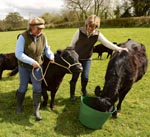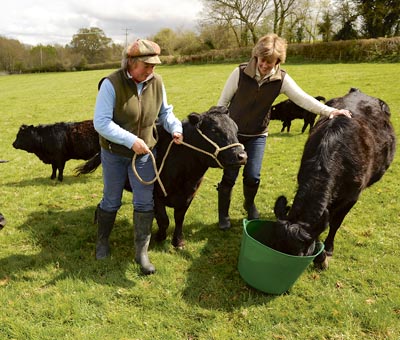Hobby Farming: The Country Life Guide
Small-scale farming can be a joyful experience, but make sure you’ve done your homework before you begin with our guide to hobby farming


My commute to work is a short one – 43 steps, to be precise, from kitchen to office. It may be short, but it's a busy, noisy one. Along the way, I have to feed five hens, one cockerel, six ducks, three lambs, two ewes, two saddleback pigs, far too many white doves and a guinea pig. And all those animals raise their voices as soon as they hear the kitchen door clunk. They know I'm the bearer of layer pellets, ewe nuts and kitchen scraps, and so, to show their appreciation and anticipation, they quack and crow and baa and grunt.
At certain times of the year, keeping livestock in a small hobby-farm way is a true joy. To have fluffy white lambs gambolling across the field outside my office window and to watch brand-new yellow cheeping chicks scuffing in the straw of the chicken run fills my heart to bursting point. Best of all are the piglets.
In old-people's homes and hospices, studies suggest that keeping dogs or cats for residents to pet is therapeutic. My suggestion would be piglets. I defy anyone who spends 30 minutes in the presence of half a dozen piglets not to feel revitalised. They're sweet, naughty, clever and hilarious. I also keep bees, and have a couple of beef cows, grazing on a small parcel of rough pasture that I bought separately to the 2½ acres that surround our west Dorset former rectory.
The emotional pay-off of keeping a medley of animals is obvious to anyone who enjoys being around livestock-they strike a chord, fulfill a need. The practical pay-off of my very amateur hobby farming is the contents of my two freezers and fridge. I haven't spent a penny in a butcher's shop or supermarket meat counter in more than eight years. We're self-sufficient in beef, eggs, pork, bacon, gammon, lamb, mutton, chicken and honey, with the occasional duck or goose making an appearance for a special celebration dinner. I have three strapping sons and a daughter, so the quantities we can consume as a family are vast.

I'd never claim that growing one's own livestock is cheaper than buying supermarket cuts. I'm sure if you totted it up, and factored in the man-hours, it would seem like a financial mug's game. Saving money isn't why I do it. I do it for the contact with the animals, the unmatchable quality of the food we produce and because it makes me happy. Even if sometimes driving to the abattoir with my first-born beef cow-I feel a mess of emotions and a lump forms in my throat. I do this not so much because I can, but because I never knew I could. I spent four-fifths of my life living in cities.
All my children, except my youngest, were born in the metropolis. We have no farming, no land-owning, no country lore in our blood. But perhaps that's precisely why it's all so exciting to me. Before I moved to Dorset 10 years ago, I didn't know the difference between a bantam and a pullet, a heifer and weaner, a hogget and a wether. And now I've birthed, raised and eaten all of them. I haven't had to swot up on animal husbandry, nor have I done complicated courses on land and livestock management-I've bent a few neighbours' ears and swapped farming favours for bacon and sausages.
Along the way, I've had some fantastic successes in both the field and the kitchen, and some scary, painful experiences, too. Watching our big ram charge and butt my two-year-old daughter in the chest, sending her twirling through the air like a rag doll, wasn't a high point-but sitting down to eat the Scotch pies I made with him a week later certainly was.
Exquisite houses, the beauty of Nature, and how to get the most from your life, straight to your inbox.
It's not for everyone. You need to be able to embrace the deep, sucking, grey February mud as well as the spring lambs' fluffy bounce. You need to be able to bang in fence posts and castrate little boy lambs. You need to be able to hump feed sacks and chase escapee pigs around the village, as your neighbours tut-tut about the damage to their begonias. You need to embrace life and death and happiness and tragedy-while living on a diet of steak and eggs. It's not everyone's cup of tea, but this town-born boy, at this stage of his family's evolution, can think of nothing else he'd rather be doing.
From field to fridge
Taking the life of an animal that you've grown fond of isn't easy. Nor does it get easier as time goes on. If anything, it gets harder. I don't keep that many animals, and so I know all of them well. I see them every day, and most I've known since they were nothing but a ball of feathers or fluff. If it wasn't hard to kill them, then there would be something wrong with me. It's a big deal, and should always be done with as much care as possible.
Cows, pigs and sheep aren't killed on my land-they're killed (by law) in an abattoir. I'm lucky in that there are two small, family-run abattoirs within half an hour's drive. There's another abattoir nearer, but it's a much bigger-scale commercial operation, and when I asked farming neighbours where they took their animals, they cautioned me against it. One even joked: ‘The trouble with that slaughterhouse is you can't be sure you're getting your own animal back-you can't even be sure it'll be the same species.'
So, you choose an abattoir like you'd choose a doctor or dentist. When I deliver an animal there, I say goodbye, give them a pat, a hug if possible, and, always, on the drive home, I experience real sadness and say a prayer. At the same time, I feel genuinely excited on the day I go to collect my meat. A good abattoir will hang a beef animal for up to 28 days. Lambs and pigs are not matured in the same way, and so have to be collected within a week. A good small abattoir will also butcher your meat. Some will make bacon and sausages for an extra charge. You can have half a pig butchered by them and bring the other half home and experiment at butchering it yourself.
There are plenty of websites, books and DVDs, including Hugh Fearnley-Whittingstall's excellent guides and courses, which explain how to turn a piece of pig into a pound of sausages. It's all eminently achievable with time, a clean kitchen, a large freezer and a few bits of kit-namely a serious mincer, a sausage pusher, a bone saw and some sharp knives.
My greatest fear is waste. I couldn't live with myself if I grew an animal, killed it and then ruined it by not butchering it properly. The truth is, a bit of planning and some proper refrigeration will get you through. If it all goes badly wrong, you just make an awful lot of mince.
Chickens, cockerels, ducks and geese I do kill myself. I stretch their necks or cut their heads off with a blunt kindling axe, which separates the vertebrae. I hold them upside down by their legs until they stop flapping never let them flap around on the ground. It's an act of respect. Once they're dead, I hang them on the tree outside my office until they've bled out. And then I pluck them while they're still warm, so the feathers come out easily and I can feel the life in them fading away in my hands.
I do this not because I enjoy it, but because I think it's important to feel it. To feel the loss. That way, I know I'll pluck every feather until the oven-ready bird looks absolutely perfect. And then I will cook it, and together we'll eat every last morsel.
People told me that if I wanted to raise animals to eat, I shouldn't give them names. I disagree. Honour them. Love them. Respect them, with every chin-dripping mouthful. Give them a good life and a good death. Let's face it-if you're going to eat meat, you might as well eat the happiest meat you possibly can.
Country Life is unlike any other magazine: the only glossy weekly on the newsstand and the only magazine that has been guest-edited by His Majesty The King not once, but twice. It is a celebration of modern rural life and all its diverse joys and pleasures — that was first published in Queen Victoria's Diamond Jubilee year. Our eclectic mixture of witty and informative content — from the most up-to-date property news and commentary and a coveted glimpse inside some of the UK's best houses and gardens, to gardening, the arts and interior design, written by experts in their field — still cannot be found in print or online, anywhere else.
